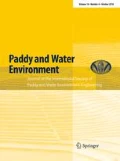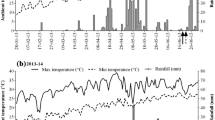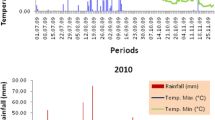Abstract
Methane (CH4) emission and water productivity were estimated in an experiment conducted during wet (rainy) season of 2010 at the research farm of Indian Agricultural Research Institute, New Delhi, India. Treatments comprising three methods of crop establishment viz., conventional transplanting (CT), system of rice intensification (SRI) and double transplanting (DT) were laid out in randomized block design with four replications. Scented rice (Oryza sativa L) variety ‘Pusa Basmati 1401’ was transplanted in puddle field. In CT and SRI 21 and 12-day-old seedlings, respectively, were transplanted while in DT overall 45-day-old seedlings were transplanted. In CT and DT flooded conditions while in SRI saturated conditions were maintained. Results indicated that among the methods of crop establishment, CT had maximum cumulative CH4 emission (32.33 kg ha−1) followed by DT (29.30 kg ha−1) and SRI (19.93 kg ha−1). Temporal CH4 flux fluctuated between 79.7 and 482.0 mg m−2 day−1 under CT; 46.0 and 315.0 mg m−2 day−1 in SRI and 86.7 and 467.3 mg m−2 day−1 in DT. Considerable temporal variations in the individual CH4 fluxes were observed. Flux of CH4 was generally higher in early stage of crop and peaked about 21 days after transplanting coinciding with tillering stage of crop. CH4 flux declined gradually from 75 days after transplanting and stabilized at the harvest stage of rice in all the three methods of transplanting. Global warming potential was highest in CT (807.4 kg CO2 ha−1) and lowest in SRI (498.25 kg CO2 ha−1). However, a reverse trend was observed with carbon efficiency ratio. The water savings to the extent of six irrigations was recorded in SRI over CT. A saving of 27.4 % irrigation water and 18.5 % total water was recorded in SRI over CT while the corresponding values of DT over CT were 14.5 and 9.8 %. Water productivity of SRI (3.56 kg/ha mm) was significantly higher as compared to DT (2.87 kg/ha mm) and CT (2.61 kg/ha mm).


Similar content being viewed by others
References
Adhya TK, Bharati K, Mohanty SR, Mishra SR, Ramakrishnan B, Rao VR, Sethunathan N (2000) Methane emission from rice fields at Cuttack, India. Nutr Cycl Agroecosyst 58:95–105
Akter MS, Islam MA, Amin HA, Bakul MRA (2008) Comparative efficiency of separated tiller vs bolon practice in aman rice. Bangladesh Res Publ J 1:255–263
Anbumozhi V, Yamaji E, Tabuchi T (1998) Rice crop growth and yield as influenced by changes in ponding water depth, water regime and fertigation level. Agric Water Manag 37:241–253
Bhatia A, Pathak H, Aggarwal PK (2005a) Inventory of methane and nitrous oxide emissions from agricultural soils of India and their global warming potential. Curr Sci 87(3):317–324
Bhatia A, Pathak H, Jain N, Singh PK, Singh AK (2005b) Global warming potential of manure amended soils under rice-wheat system in the Indo-Gangetic plains. Atm Environ 39:6976–6984
Bhattacharya S, Mitra AP (1998) Greenhouse gas emissions in India for the base year 1990. Glob Change 11:30–39
Bhuiyan SI, Tuong TP (1995) Water use in rice production: issues, research opportunities and policy implications. Paper presented at the inter-center water management workshop, 29–30 September 1995. International Irrigation Management Institute, Colombo
Bouman BAM (2007) A conceptual framework for the improvement of crop productivity at different spatial scales. Agric Syst 93:43–60
Boundia LV, Neue HU, Wassmann R, Lantin RS, Javellana AM, Arah J, Xu Y, Makarim AK, Corton T, Charoenship N (1996) Understanding the nature of methane emission from rice ecosystem as a basis for mitigation strategies. In: Proceedings of international symposium on maximizing sustainable rice yields through improved soil and environmental management, Khon Kaen, pp. 291–314
Cai ZS, Tsurata H, Minami K (2000) Methane emissions from rice field in China: measurement and influencing factors. J Geophys Res 105(13):17231–17242
Cai Z, Sawamoto T, Li C, Kang G, Boonjawat J, Mosier A, Wassmann R, Tsuruta H (2003) Field validation of the DNDC model for greenhouse gas emissions in East Asian cropping systems. Glob Biogeochem Cycles 17:1104–1107
Cai Z, Shan Y, Xu H (2007) Effects of nitrogen fertilization on CH4 emissions from rice fields. Soil Sci Plant Nutr 53:353–361
Chapagain T, Yamaji E (2010) The effects of irrigation method, age of seedling and spacing on crop performance, productivity and water-wise rice production in Japan. Paddy Water Environ 8(1):81–90
Cicerone RJ, Oremland RS (1988) Biogeochemical aspects of atmospheric methane. Glob Biochem Cycles 2:299–327
Davids G (1998) Use of the capital intensive irrigation systems in rice. Davids Engineering, Inc. California, USA
Ghosh S, Jain MC, Sinha S (1995) Estimates of global methane production from rice paddies based on substrate requirement. Curr Sci 69:937–939
Guerra LC, Bhuiyan SI, Tuong TP, Barker R (1998) Producing more rice with less water from irrigated systems. SWIM Paper 5. International Irrigation Management Institute, Colombo
Hadi A, Inubushi K, Yagi K (2010) Effect of water management on greenhouse gas emissions and microbial properties of paddy soils in Japan and Indonesia. Paddy Water Environ 8:319–324
IPCC (1995) Scientific-technical analyses of impacts, adaptations and mitigation of climate change. Report of IPCC Working Group II
IPCC (2007) Climate change 2007—the physical science basis contribution of working group I to the fourth assessment report of the IPCC. Cambridge University Press, New York
Jugsujinda A, Delaune RD, Lindau CW, Sulaeman E, Pezeshki SR (1996) Factors controlling carbon dioxide and methane production in acid sulfate soils. Water Air Soil Pollut 87:345–355
Keisuke S, Yamaji E, Sato S, Budhiharto PS, Mizoguchi M (2007) Sustainability of system of rice intensification: benefits of SRI focusing on effects of intermittent irrigation on yield increase and water savings. In: Proceeding of PAWEES 2007 6th international conference on sustainable rural development and management, Seoul National University, Seoul, 18 Oct 2007, pp 25–37
Khalil MAK, Shearer MJ, Rasmussen RA, Xu L, Liu JL (2008) Methane and nitrous oxide emissions from subtropical rice agriculture in China. J Geophy Res 113:G00A05
Kludze HK, DeLaune RD, Patrick WH (1993) Aerenchyma formation and methane and oxygen exchange in rice. Soil Sci Soc Am J 51:386–391
Kumaraswamy S, Rath AK, Ramakrishnan B, Sethunathan N (2000) Wetland rice soils as sources and sinks of methane: a review and prospects for research. Biol Fertil Soils 31(6):449–461
Lindau CW, Bollich PK, Delaune RD, Patrick WH, Law VJ (1991) Effects of urea fertilizer and environmental factors on CH4 emissions from Louisiana, USA rice field. Plant Soil 136:195–203
Mao Z (1993) Principle and technique of water saving irrigation for rice. Wuhan University of Hydraulic and Electric Engineering, Wuhan
Mao Z (1996) Environmental impact of water-saving irrigation for rice. In: Irrigation scheduling: from theory to practice. Proceedings of the ICID/FAO workshop on irrigation scheduling, Rome. FAO, Rome, 12–13 Sept 1995
Mosier A, Schimel D, Valentine D, Bronson K, Parton W (1998) Methane and nitrous oxide fluxes in native, fertilized and cultivated grasslands. Soil Biol Biochem 30(14):2087–2098
Mosier A, King J, Palm C (2004) Methane and nitrous oxide fluxes in tropical agricultural soils: sources, sinks and mechanism. Environ Dev Sustain 6:11–49
Nugroho SG, Lumbanraja J, Suprapto H, Kimura M (1994) Effect of intermittent irrigation on methane emission from and Indonesian paddy field. Soil Sci Plant Nutr 42:609–615
Pathak H, Bhatia A, Prasad S, Singh S, Kumar S, Jain MC, Kumar U (2002) Emission of nitrous oxide from rice–wheat systems of Indo-Gangetic plains of India. Environ Monit Assess 77(2):163–178
Pathak H, Prasad S, Bhatia A, Singh S, Kumar S, Singh J, Jain MC (2003) Methane emission from rice-wheat cropping system of India in relation to irrigation, farmyard manure and di-cyandiamide application. Agric Ecosyst Environ 97:309–316
Rautray SK (2006) Yield and economics of promising rice (Oryza sativa) hybrids under double transplanting in late spring summer (boro) situation. Indian J Agric Sci 76(8):469–471
Sato S, Uphoff N (2007) A review of on-farm evaluation of system of rice intensification (SRI) methods in eastern Indonesia. CAB Reviews. Commonwealth Agricultural Bureau International, Wallingford, UK, pp 67–87
Singh JS, Singh S, Raghubanshi AS, Singh S, Kashyap AK (1996) Methane flux from rice/wheat agroecosystem as affected by crop phenology, fertilization and water level. Plant Soil 183(2):323–327
Stoop WA, Kassam A (2002) A review of agricultural research issue raised by the system of rice intensification (SRI) from Madagascar: opportunities for improving system for resource poor farmers. Agric Syst 71:249–274
Tabbal DF, Lampayan RM, Bhuiyan SI (1992) Water-efficient irrigation technique for rice. In: Murty VVN, Koga K (eds) Soil and water engineering for paddy field management. In: Proceedings of the international workshop on soil and water engineering for paddy field management. Asian Institute of Technology, Bangkok, 28–30 Jan 1992
Tabbal DF, Bouman BAM, Bhuiyan SI, Sibayan EB, Sattar MA (2002) On-farm strategies for reducing water input in irrigated rice: case studies in the Philippines. Agric Water Manag 56:93–112
Takai Y, Koyoma T, Kamura T (1956) Microbial metabolism in reduction process of paddy soils. J Soil Plant Food 2:63–66
Thiyagarajan TM, Senthikumar K, Sindraban PS, Hengsdijk H, Ramasamy S, Velu V, Durgadevi D, Vogindarajan K, Priyadarshini R, Sudhalakshmi C, Mishra PT, Gayathry G (2002) Crop management options for increasing water productivity in rice. J Agric Resour 7(4):169–181
Uphoff N (2007) Reducing the vulnerability of rural households through agroecological practice: considering the system of rice intensification (SRI). Mondes Dév 35:4–8
Watanabe A, Kimura M (1996) Factors affecting intervarietal variations in methane emission from rice paddies. In: International workshop on paddy fields: sustainable agriculture and control of greenhouse gas emissions, March 7–8, Tsukuba, Japan, pp 77–90
Watson RT, Zinyowera MC, Moss RH, Dokken DJ (1996) Climate Change impacts, adaptations and mitigation of climate change: scientific-technical analyses, intergovernmental panel on climate change. Cambridge University Press, New York, p 879
Xiong ZQ, Xing GX, Zhu ZL (2007) Nitrous oxide and methane emissions as affected by water, soil and nitrogen. Pedosphere 17:146–155
Yan X, Yagi K, Akiyama H, Akimoto H (2005) Statistical analysis of the major variables controlling methane emission from rice fields. Glob Change Biol 11:55–63
Yan X, Akiyama H, Yagi K, Akimoto H (2009) Global estimation of the inventory and mitigation potential of methane emissions from rice cultivation conducted using the 2006 intergovernmental panel on climate change guidelines. Glob Biogeochem Cycles 23:10–20
Yang S, Chang H (1998) Effect of environmental conditions on methane production and emission from paddy soil. Agric Ecosyst Environ 69(1):69–80
Ying Z, Boecky P, Chen GX, Van Cleemput O (2000) Influence of Azolla on methane emission from rice fields. Nutr Cycl Agroecosyst 58:321–326
Yoshida T (1978) Microbial metabolism in rice soils. In: IRRI (ed) Soil and rice. IRRI, Los Banos, pp 445–463
Zhang L, Yu D, Shi X, Weindorf D, Zhao L, Ding W, Wang H, Pan J, Li CS (1998) Quantifying methane emissions from rice fields in the Taihu Lake region, China by coupling a detailed soil database with biogeochemical model. Biogeoscience 6:739–749
Zou J, Houng Y, Jiang J, Zheng X, Sass RL (2005) 2-Year field measurement of CH4 and N2O emissions from rice paddies in China: effects of water regime, crop residue and fertiliser application. Glob Biogeochem Cycle 19:2021
Author information
Authors and Affiliations
Corresponding author
Rights and permissions
About this article
Cite this article
Suryavanshi, P., Singh, Y.V., Prasanna, R. et al. Pattern of methane emission and water productivity under different methods of rice crop establishment. Paddy Water Environ 11, 321–329 (2013). https://doi.org/10.1007/s10333-012-0323-5
Received:
Revised:
Accepted:
Published:
Issue Date:
DOI: https://doi.org/10.1007/s10333-012-0323-5




